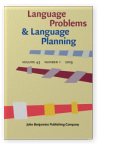Vol. 43:1 (2019) ► pp.55–73
Reviewing reform
Studies of script reform in contemporary Japan
The transformation of the contemporary Japanese writing system stemmed from the simultaneous political and cultural problematizing of so-called kokugo (national language) and kokuji (national script). Debates surrounding the structure and function of the written form of Japanese played an ongoing role in Japanese language reform proposals and policy planning initiated between the mid-1860s and early 1990s. Despite the long history of the debates and the large body of literature treating them, a comprehensive review of the scholarship dealing with the various dimensions of Japanese script reform is currently unavailable. This article provides a detailed overview and analysis of studies of the Japanese script reform debates that utilise contemporary works describing the origins and development of language problems and language rights issues. The article subsequently considers the possibilities for future inquiries involving transnational and post-national aspects of script reform, whilst reflecting on the conspicuously gendered and ethnic dimensions of contemporary Japanese language policy-formulation itself.
Article outline
- Script reform in contemporary Japan
- Reviewing reform
- Viewing script reform through contemporary scholarship
- Other key issues encompassing script reform
- Conclusion
- Notes
-
References
References
References marked with an asterisk (*) indicate studies included in the meta-analysis.
